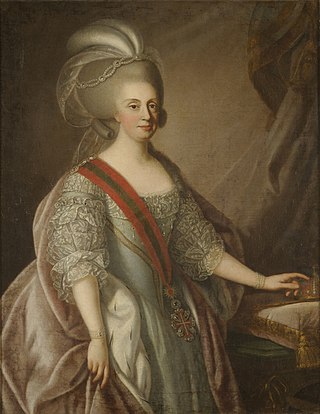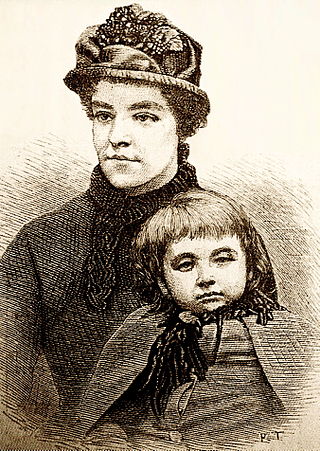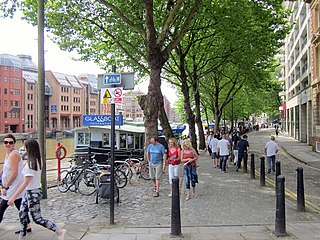Related Research Articles

Oriel College is a constituent college of the University of Oxford in Oxford, England. Located in Oriel Square, the college has the distinction of being the oldest royal foundation in Oxford. In recognition of this royal connection, the college has also been historically known as King's College and King's Hall. The reigning monarch of the United Kingdom is the official visitor of the college.

Dona Maria I was Queen of Portugal from 24 February 1777 until her death in 1816. Known as Maria the Pious in Portugal and Maria the Mad in Brazil, she was the first undisputed queen regnant of Portugal and the first monarch of Brazil.

Sproughton is a village in Suffolk, England, just to the west of Ipswich and is in the Babergh administrative district. It has a church, a primary school, a pub, a community shop and various groups. It is in the Belstead Brook electoral division of Suffolk County Council.

John Scandrett Harford, FRS was a British banker, benefactor and abolitionist.

Elizabeth of Aragon, more commonly known as Saint Elizabeth of Portugal, T.O.S.F., was queen consort of Portugal, a tertiary of the Franciscan Order and is venerated as a saint of the Catholic Church.

Kington Langley is a village and civil parish about 2 miles (3.2 km) north of Chippenham in Wiltshire, England. The parish includes the hamlet of Bowldown.

Sir Thomas White was an English cloth merchant, Lord Mayor of London in 1553, and a civic benefactor and founder of St John's College, Oxford.

Dorcas, or Tabitha, was an early disciple of Jesus mentioned in the Acts of the Apostles. She lived in the port city of Joppa, today absorbed by Tel Aviv. Acts describes her as being known for her "good works and acts of mercy", sewing clothes for the poor. When she died, the widows of her community mourned her and sent urgently for Peter, who was in nearby Lydda. As evidence of her charity, they showed him some of the clothes she had sewn, and according to the biblical account he raised her from the dead.

Godstow is about 2.5 miles (4 km) northwest of the centre of Oxford. It lies on the banks of the River Thames between the villages of Wolvercote to the east and Wytham to the west. The ruins of Godstow Abbey, also known as Godstow Nunnery, are here. A bridge spans the Thames and the Trout Inn is at the foot of the bridge across the river from the abbey ruins. There is also a weir and Godstow lock.

The Queen's School is an independent day school for girls aged 4–18 located in Chester, England. Founded in 1878 as "The Chester School for Girls", Queen Victoria, who was the school's first patron, issued a royal decree naming the school as "The Queen's School" in 1882, the only school in England to have this distinction. It is a member of the Girls' Schools Association.

Holy Trinity Church is a Church of England parish church in Westbury-on-Trym, Bristol, England.

St Mark's Church is an ancient church on the north-east side of College Green, Bristol, England, built c. 1230. Better known to mediaeval and Tudor historians as the Gaunt's Chapel, it has also been known within Bristol since 1722 as the Lord Mayor's Chapel. It is one of only two churches in England privately owned and used for worship by a city corporation. The other is St Lawrence Jewry, London. It stands opposite St Augustine's Abbey, founded by a member of the Berkeley family of nearby Berkeley Castle, from which it was originally separated by the Abbey's burial ground, now called College Green. It was built as the chapel to the adjacent Gaunt's Hospital, now demolished, founded in 1220. Except for the west front, the church has been enclosed by later adjacent buildings, although the tower is still visible. The church contains some fine late gothic features and a collection of continental stained glass. It is designated by Historic England as a grade I listed building.

All Saints is a closed Anglican church in Corn Street, Bristol. For many years it was used as a Diocesan Education Centre but this closed in 2015. The building has been designated as a grade II* listed building.

Ellingham is a small village near Ringwood in Hampshire, England, west of the New Forest National Park. It is in the civil parish of Ellingham, Harbridge and Ibsley. Ellingham is most famous for the story of Alice Lisle, who was executed by the infamous Judge Jeffreys in 1685, on the charge of harbouring fugitives after the defeat of the Monmouth Rebellion.

Alice Ayres was an English nursemaid honoured for her bravery in rescuing the children in her care from a house fire. Ayres was a household assistant and nursemaid to the family of her brother-in-law and sister, Henry and Mary Ann Chandler. The Chandlers owned an oil and paint shop in Union Street, Southwark, then just south of London, and Ayres lived with the family above the shop. In 1885 fire broke out in the shop, and Ayres rescued three of her nieces from the burning building, before falling from a window and suffering fatal injury.
Alice Bemis Taylor was a philanthropist and was inducted into the Colorado Women's Hall of Fame in 2010.
William Meschin was an Anglo-Norman nobleman and baron. The brother of the earl of Chester, Meschin participated in the First Crusade. After returning to England, he acquired lands both from King Henry I of England and by his marriage to an heiress.
Elizabeth Hussey, later Elizabeth Crane and Elizabeth Carleton, was a religious activist with strong Puritan sympathies. She and her second husband, George Carleton, were prosecuted for involvement in the Marprelate controversy. The first of the anonymous Marprelate tracts, Martin's Epistle, was printed at her home in East Molesey, Surrey, in October 1588.

Welsh Back is a wharf and street alongside the floating harbour in the centre of the city of Bristol, England. The wharf and street extend some 450 metres (1,480 ft) along the west side of the harbour between Bristol Bridge and Redcliffe Bridge. At the northern end, the street and wharf are immediately adjacent, but to the south they are separated by a range of single story transit sheds. The wharf is a grade II listed structure and takes its name because it was freqented by vessels from Welsh ports.

Blanche Gibbs also known as Matilda Blanche Gibbs or Matilda Blanche Crawley-Boevey, was an English philanthropist, and a supporter of the Oxford Movement in 19th century England. Along with her husband, William Gibbs, a businessman, she funded the establishment and restoration of many churches and religious structures. After his death, as the inheritor of his estate, she expanded her philanthropy towards social and welfare efforts including the creation of convalescent homes, hospitals, and educational institutions.
References
- ↑ Burgess, Clive (ed.), The Pre-Reformation Records of All Saints, Bristol: Part 1, Bristol Record Society, 1995
- Burges, Clive. "Alice Chestre". In Matthew, H.C.G. and Brian Harrison, eds. The Oxford Dictionary of National Biography. vol. 11, 352–3. London: OUP, 2004.
- Jean Manco, The House that Alice Built